 In March 2012, an incident during a televised football match shone a light on the trauma of sudden cardiac arrest. In an FA Cup tie between Tottenham Hotspur and Bolton Wanderers, at White Hart Lane, Bolton’s 23 year old midfielder, Fabrice Muamba, suddenly collapsed on the pitch. Thousands in the ground and millions more at home watched in horror as medics ran onto the pitch and spent many minutes trying to revive him.
In March 2012, an incident during a televised football match shone a light on the trauma of sudden cardiac arrest. In an FA Cup tie between Tottenham Hotspur and Bolton Wanderers, at White Hart Lane, Bolton’s 23 year old midfielder, Fabrice Muamba, suddenly collapsed on the pitch. Thousands in the ground and millions more at home watched in horror as medics ran onto the pitch and spent many minutes trying to revive him.
Despite ultimately spelling the end of a successful career as a professional footballer, thanks to the quick responses of the team doctors who used an AED (automated external defibrillator) and the assistance of a Tottenham fan and consultant cardiologist who ran onto the pitch to help, he made made a slow, but almost full, recovery.
Others in the sport have not been so fortunate. Marc-Vivien Foé died whilst representing Cameroon in the 2003 FIFA Confederation Cup, Antonia Puerta collapsed and died whilst playing for Sevilla in a Spanish league game and Motherwell’s Phil O’Donnell collapsed during a Scottish league game and died later in hospital.
Thankfully these incidents are rare, but they do raise the question of whether participation in sport raises the risk of SCD (sudden cardiac death). A study made in 2003 suggests an increased risk of sudden cardiac death of almost three times for athletes compared to their non-athletic counterparts whilst more recent data suggests the opposite.
- The difference between cardiac arrest and heart attack is not always understood. A cardiac arrest is a sudden ‘electrical’ malfunction of the heart. An AED may be used to ‘jump start’ the heart in the event of such an incident. A heart attack is caused by the arteries becoming blocked – a circulation problem – and may come on more gradually. However, a heart attack can trigger a cardiac arrest.
Studies around the world
On average, every three days in the United States a competitive athlete experiences an SCD, and many of these deaths receive publicity nationally. However, this same focus is not applied to a non-athlete or indeed to a competitive athlete who has SCD off the athletic field. On the basis of reports in the media it would appear that SCD deaths in athletes are much more common than in non-athletes. However, the data supporting such a claim has limitations.
A study in Hamburg, Germany found that around 0.3% of the fatalities subjected to an autopsy between 1997 and 2006 were identified as sports related. In Denmark a study of competitive athletes between the ages of 12 and 35 in the years 2000-2006 found 15 cases of SCD during, or within one hour of a sporting activity. This was a rate that was more than three times lower than that of the general population.
Thus the data from these studies is inconclusive. It is not always clearly recorded as to whether casualties were in fact athletes and distinctions have not always been made between competitive athletes and those carrying out recreational athletic activity.
There is insufficient evidence, for example, to determine whether a so-called ‘non-athlete’ might have engaged in what could be determined as athletic activity shortly before their death –for example jogging to keep fit. Much of the existing data is limited by its observational nature.
Sudden deaths during marathon running attract much media attention due to their rarity and unpredictability. The London Marathon, one of the largest in the world, now attracts around 40,000 participants. In its 35-year history, 14 participants have died. Research into marathons have given result that the likelihood of a fatality is somewhere between 0.0005 and 0.002% of runners. Interestingly one study in 2012 found that runners below the age of 40 were up to seven times as likely to die as those in the older age bracket. This is because older runners were more likely to have ischemic heart disease (narrowing or blockage) of the arteries that supply blood to the heart muscle, a condition that’s more responsive to resuscitation.
If athletes who die suddenly had advanced cardiac disease, they would have most likely been at high risk of dying unexpectedly, whether or not they had exercised. A number of studies have attempted to determine whether or not exercise increases the risk that persons with advanced heart disease will die suddenly during exercise rather than at rest. Some have found that moderate exercise does not increase the risk of sudden death, whereas others have found that more vigorous forms of exercise greatly increase the risk of sudden death.
Screening
The interest in athletic sudden death arises in part from both the prominence of sport across the world and the apparent contradiction that physical activity can have both a positive and negative impact on a person’s health. It is apparent that strong exertion increases the risk of SCD in individuals with cardiovascular disease.
CRY (Cardiac Risk in the Young) is a charity that believes that proactive cardiac screening is vitally important and should be accessible to all young people aged 14-35. It reports that every week in the UK, around 12 people under the age of 35 die suddenly from a previously undiagnosed heart condition. 80% of these deaths will occur with no prior symptoms, which is why the organisation backs screening so passionately. In itself, sport does cause sudden cardiac death, but it is believed that it can significantly increase a person’s risk if they have an underlying condition.
However, scanning only detects 60-80% of conditions. For example, Bolton footballer Fabrice Muamba had been screened three times but still suffered a cardiac arrest when he was playing.
In April 2016 the British Medical Journal (BMJ) published research data produced by the Belgian Health Care Knowledge Centre that cast severe doubt upon the wisdom of carrying out screening. It set out the belief that the harms outweighed any benefits and that there is no strong evidence that it actually prevents deaths. However the conclusions reached were strongly criticised by professors from the University of Padova, Italy.
In Italy a national screening program with ECGs, stress tests, and selective use of echocardiograms has been performed since 1982 and has been associated with a decrease in fatalities. The basis of the program is the belief that athletes are higher risk of SCD than other members of the population and as a result 2% of athletes were excluded from sporting participation. In the response published on the BMJ website the Italian professors stated that “the systematic pre-participation evaluation, coupled with sports restriction, resulted in a decline in SCD among screened athletes from 3.6 per 100 000 person-years in the two years before screening implementation to 0.4 per 100 000 person years two decades later.”
Further research is needed to assess both the physical and emotional results of restricting athletic activity and the effect of athletic screening programs. It is very possible that a significant number of athletes could be needlessly restricted from taking part in sport due to being incorrectly assessed as having a cardiac condition that could result in SCD.
The need for defibrillators
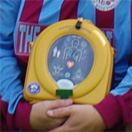 No matter how closely one studies the statistics, a cardiac arrest remains an unpredictable event. For this reason the increasing prevalence of AEDs in public places is a very welcome. It remains true that a cardiac arrest outside of hospital and with no trained people nearby, results in a survival rate of just 6%. If there is a defibrillator to hand this rises to around 60%.
No matter how closely one studies the statistics, a cardiac arrest remains an unpredictable event. For this reason the increasing prevalence of AEDs in public places is a very welcome. It remains true that a cardiac arrest outside of hospital and with no trained people nearby, results in a survival rate of just 6%. If there is a defibrillator to hand this rises to around 60%.
To return to the story of the Bolton Wanderers footballer Fabrice Muamba whose life was saved with the aid of an AED: since his collapse he has been involved in a number of campaigns to get more defibrillators into public places.
“If it wasn’t for a defibrillator I wouldn’t be here today, he said, “I was lucky. I had my cardiac arrest in the right place with the best medics around to help me. I want everyone who goes into cardiac arrest to have the same chance as me and that’s why I’m supporting the London Ambulance Service campaign to get more defibrillators in public places.”
He helped launch the campaign to get 1,000 of the machines into shops, businesses and gyms.
Defibrillators are now standard equipment at most professional football grounds and they are increasingly finding their way into sports centres. There are several charities that help to place defibrillators in schools and sports clubs, including Lucky2Bhere and Hand on Heart, while the National Sports First Aid course is ideal for coaches and teachers to learn CPR.
Sadly, on consecutive days in September 2016, the BBC website reported the sudden death of two footballers whilst playing in matches. One, a 24 year old was formerly on the books of Hull City but playing in the Northern Premier League. The other was a former West African international who was playing in the French Cup.
Whilst the correlation between SCD and athletic exercise continues to be researched, attention is being focused on the steps that are being taken to address cardiac arrests when they occur. One lesson that is being learnt is that every effort should be made to ensure that defibrillators are readily available in as many public places as possible.
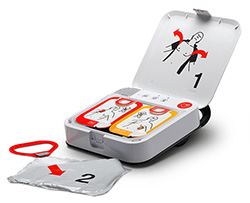 When someone suffers a sudden cardiac arrest (SCA) it can be daunting for those around them. Having an easy-to-use defibrillator can speed up the delivery of a shock, increases the chance of survival and enables the person performing CPR to do so effectively and with confidence. Physio Control Lifepak CR2 Defibrillator has the technology to do this.
When someone suffers a sudden cardiac arrest (SCA) it can be daunting for those around them. Having an easy-to-use defibrillator can speed up the delivery of a shock, increases the chance of survival and enables the person performing CPR to do so effectively and with confidence. Physio Control Lifepak CR2 Defibrillator has the technology to do this.


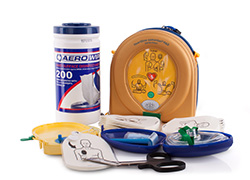 The SAM 500P Trainer unit comes supplied with a remote control, giving you as the trainer full control over the simulation of the unit. Being able to remotely select from six different scenarios will give attendees the best training experience possible. This trainer unit does everything a real defibrillator does except it cannot administer a shock. Providing a learning experience that replicates that of the real life event will build trainees’ confidence and retention of the skills, maximising their effectiveness in the time of need. The kit also includes a preparation kit so that course delegates can really practice what they would do in the event of someone in their workplace suffering from a cardiac arrest, from cutting clothing to free the chest and also chest preparation.
The SAM 500P Trainer unit comes supplied with a remote control, giving you as the trainer full control over the simulation of the unit. Being able to remotely select from six different scenarios will give attendees the best training experience possible. This trainer unit does everything a real defibrillator does except it cannot administer a shock. Providing a learning experience that replicates that of the real life event will build trainees’ confidence and retention of the skills, maximising their effectiveness in the time of need. The kit also includes a preparation kit so that course delegates can really practice what they would do in the event of someone in their workplace suffering from a cardiac arrest, from cutting clothing to free the chest and also chest preparation.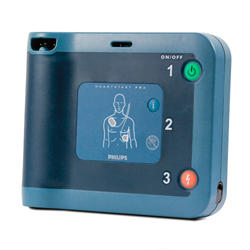
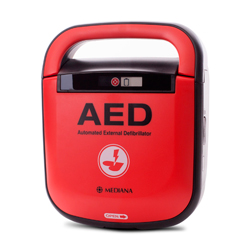
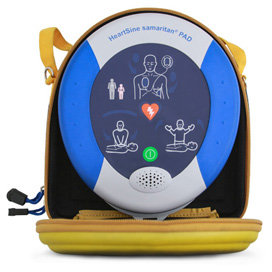 The 1st of June sees not only the start of National Heart Rhythm Week, but also the launch of The Defib Pad’s amazing AED (automated external defibrillator) special offer!
The 1st of June sees not only the start of National Heart Rhythm Week, but also the launch of The Defib Pad’s amazing AED (automated external defibrillator) special offer!